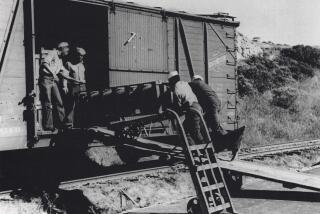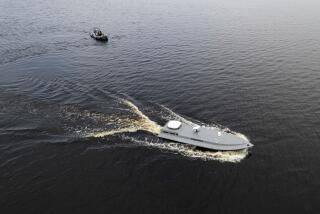Soviets Arrest Both Captains in Ship Disaster : Skippers Accused of Violating Safety Rules in Black Sea Collision
- Share via
MOSCOW — The captains of both ships involved in the Black Sea collision that caused the deaths of almost 400 people have been arrested for violating maritime safety rules, a senior Soviet official said Thursday.
Albert I. Vlasov, deputy head of the propaganda department of the Communist Party Central Committee, said a government commission is investigating the Sunday night accident, assisted by state prosecutors, and will submit a report to a court that will hear the charges. The official said the two captains could be sent to prison.
The official death toll in the collision was raised to 116 Thursday, but the authorities made clear their doubts that any of the 282 people from the sunken liner who are still listed as missing will be found alive. A total of 836 people were rescued from the passenger liner, the Admiral Nakhimov, which was carrying Soviet tourists on the Black Sea.
Diver Get No Response
Divers reportedly have descended more than 150 feet to the floor of the sea and tapped on the hull of the liner to see if any passengers were trapped in air pockets inside, but have elicited no response.
Vlasov disclosed the detention of the two commanding officers, Capt. Vadim Markov of the passenger liner and Capt. Viktor Katchenko of the freighter Pyotr Vasev. Markov had commanded the liner since 1959; Katchenko the freighter since 1980.
Vlasov said the freighter had violated the rules of navigation by not yielding the right of way to the liner. He did not specify what regulation or regulations the liner’s captain was accused of violating.
Share the Blame
Pravda, the Communist Party newspaper, said the two officers share the blame for the collision. It quoted maritime specialists as saying that the liner could have taken evasive action once its officers saw that the freighter was on a collision course. The official Soviet press had already reported that the liner’s helmsman repeatedly asked the freighter to change course to avoid a collision.
Two other official newspapers said the accident resulted from “slovenliness and carelessness.”
The government commission, headed by Geidar A. Aliyev, a member of the Politburo, will examine documents and the record of communications between the ships and the harbor authorities and also question members of the crews of both vessels.
“While the two captains are still being interrogated and investigated, the guilt of each of the captains will be established,” Vlasov told reporters. No one else has been arrested.
Soviet officials said the freighter rammed into the starboard side of the passenger ship, almost breaking it in two.
“The situation was difficult in the extreme,” Vlasov said, pointing out that the accident occurred in darkness and in a heavy sea, and that the liner went down within seven or eight minutes after the collision.
He said the liner sank so quickly that the crews were prevented from launching lifeboats and the passengers and crew members were forced to use small, inflatable rafts to save themselves.
Still, he said, the rescue of 836 people from the sinking liner was an impressive display of courage and efficiency and was “very well organized.”
A force of 20 helicopters, 60 small craft and 20 divers was assembled to deal with the situation, Vlasov added.
The press briefing by Vlasov, a senior party official, was the second unusually candid report on the Black Sea incident. In the past, strict secrecy has been imposed on disasters in this country. Rarely, for example, have the authorities permitted a detailed public account of an airplane crash, particularly the death toll, unless foreigners were involved.
Vlasov said the commission’s findings will be made public but he cautioned that “it will take some time.”
At the moment, he said, the investigation is taking place mainly under water. He said that after a thorough examination of the hull the divers will decide whether to enter the ship and search for more bodies.
No decision has been made on whether to try to salvage the ship, which was built in 1925, in Germany. It was taken over by the Soviet Union after World War II.
More to Read
Sign up for Essential California
The most important California stories and recommendations in your inbox every morning.
You may occasionally receive promotional content from the Los Angeles Times.










